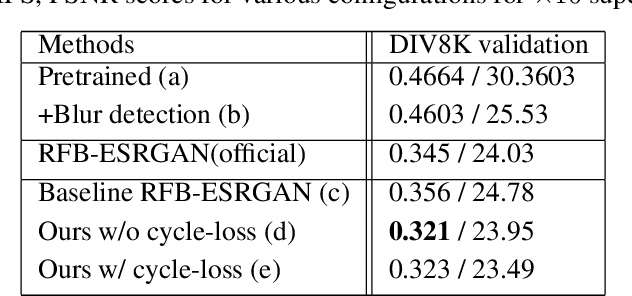Eunho Lee
Automatic Channel Pruning for Multi-Head Attention
May 31, 2024Abstract:Despite the strong performance of Transformers, their quadratic computation complexity presents challenges in applying them to vision tasks. Automatic pruning is one of effective methods for reducing computation complexity without heuristic approaches. However, directly applying it to multi-head attention is not straightforward due to channel misalignment. In this paper, we propose an automatic channel pruning method to take into account the multi-head attention mechanism. First, we incorporate channel similarity-based weights into the pruning indicator to preserve more informative channels in each head. Then, we adjust pruning indicator to enforce removal of channels in equal proportions across all heads, preventing the channel misalignment. We also add a reweight module to compensate for information loss resulting from channel removal, and an effective initialization step for pruning indicator based on difference of attention between original structure and each channel. Our proposed method can be used to not only original attention, but also linear attention, which is more efficient as linear complexity with respect to the number of tokens. On ImageNet-1K, applying our pruning method to the FLattenTransformer, which includes both attention mechanisms, shows outperformed accuracy for several MACs compared with previous state-of-the-art efficient models and pruned methods. Code will be available soon.
Toward Robust LiDAR based 3D Object Detection via Density-Aware Adaptive Thresholding
Apr 22, 2024Abstract:Robust 3D object detection is a core challenge for autonomous mobile systems in field robotics. To tackle this issue, many researchers have demonstrated improvements in 3D object detection performance in datasets. However, real-world urban scenarios with unstructured and dynamic situations can still lead to numerous false positives, posing a challenge for robust 3D object detection models. This paper presents a post-processing algorithm that dynamically adjusts object detection thresholds based on the distance from the ego-vehicle. 3D object detection models usually perform well in detecting nearby objects but may exhibit suboptimal performance for distant ones. While conventional perception algorithms typically employ a single threshold in post-processing, the proposed algorithm addresses this issue by employing adaptive thresholds based on the distance from the ego-vehicle, minimizing false negatives and reducing false positives in urban scenarios. The results show performance enhancements in 3D object detection models across a range of scenarios, not only in dynamic urban road conditions but also in scenarios involving adverse weather conditions.
NeuroFlow: Development of lightweight and efficient model integration scheduling strategy for autonomous driving system
Dec 15, 2023Abstract:This paper proposes a specialized autonomous driving system that takes into account the unique constraints and characteristics of automotive systems, aiming for innovative advancements in autonomous driving technology. The proposed system systematically analyzes the intricate data flow in autonomous driving and provides functionality to dynamically adjust various factors that influence deep learning models. Additionally, for algorithms that do not rely on deep learning models, the system analyzes the flow to determine resource allocation priorities. In essence, the system optimizes data flow and schedules efficiently to ensure real-time performance and safety. The proposed system was implemented in actual autonomous vehicles and experimentally validated across various driving scenarios. The experimental results provide evidence of the system's stable inference and effective control of autonomous vehicles, marking a significant turning point in the development of autonomous driving systems.
One-to-many Approach for Improving Super-Resolution
Jun 22, 2021



Abstract:Super-resolution (SR) is a one-to-many task with multiple possible solutions. However, previous works were not concerned about this characteristic. For a one-to-many pipeline, the generator should be able to generate multiple estimates of the reconstruction, and not be penalized for generating similar and equally realistic images. To achieve this, we propose adding weighted pixel-wise noise after every Residual-in-Residual Dense Block (RRDB) to enable the generator to generate various images. We modify the strict content loss to not penalize the stochastic variation in reconstructed images as long as it has consistent content. Additionally, we observe that there are out-of-focus regions in the DIV2K, DIV8K datasets that provide unhelpful guidelines. We filter blurry regions in the training data using the method of [10]. Finally, we modify the discriminator to receive the low-resolution image as a reference image along with the target image to provide better feedback to the generator. Using our proposed methods, we were able to improve the performance of ESRGAN in x4 perceptual SR and achieve the state-of-the-art LPIPS score in x16 perceptual extreme SR.
 Add to Chrome
Add to Chrome Add to Firefox
Add to Firefox Add to Edge
Add to Edge